New Mexico hosts a wide range of tarantulas that inhabit deserts, grasslands, and rocky slopes across the state. These large and furry spiders play an important ecological role by keeping insect populations under control and contributing to the natural balance of desert ecosystems. Though intimidating in appearance, they are calm, secretive, and rarely pose a threat to humans.
Each species of Aphonopelma in New Mexico has adapted to specific conditions, thriving in areas with loose soil, sparse vegetation, and seasonal rainfall. Their earthy tones, ranging from golden blonde to deep brown, provide excellent camouflage against sand and stone. These physical and behavioral traits make them highly suited to the state’s hot, arid climate.
Spotting a tarantula in the wild is a fascinating experience that highlights the beauty and resilience of desert life. They can be seen wandering after summer rains or waiting silently near the entrance of their burrows at night. Observing these creatures offers a deeper appreciation for the rich biodiversity hidden within New Mexico’s rugged landscapes.
Common Types of Tarantulas Found in New Mexico
Aphonopelma hentzi (Texas Brown Tarantula / Oklahoma Brown Tarantula)
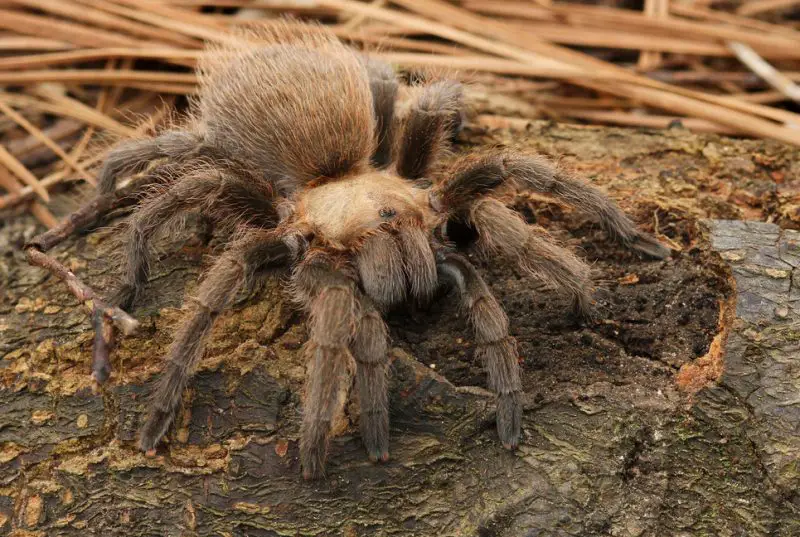
The Texas Brown Tarantula, scientifically known as Aphonopelma hentzi, is one of the most recognizable tarantulas in New Mexico and the southwestern United States. It has a large, hairy body that ranges in color from dark brown to black, often with lighter brown legs. Adult females typically measure around 4 to 5 inches across, while males are slightly smaller but possess longer legs. The species’ robust appearance and dense setae help it blend into the desert and grassland terrain it inhabits.
This tarantula is known for its calm temperament and slow-moving behavior. It is primarily nocturnal, emerging from its burrow at night to hunt insects, small lizards, and other invertebrates. During the day, it remains hidden underground or beneath rocks to avoid the heat and predators. When threatened, it may raise its front legs and expose its fangs as a warning, though it rarely bites unless provoked.
Aphonopelma hentzi prefers dry environments, thriving in desert grasslands, scrublands, and rocky hillsides across southern and eastern New Mexico. Its burrows are often lined with silk and can be found near dry washes or beneath vegetation that offers shade. These burrows provide a stable temperature and humidity level, essential for molting and survival in harsh desert conditions.
Females of this species are long-lived, often surviving for more than 20 years in the wild, while males usually live only a few years after reaching maturity. Mating occurs in late summer and early fall, after which the female lays a large egg sac containing dozens of spiderlings. The young disperse in early summer, continuing the cycle that makes this tarantula one of the region’s most resilient arachnids.
Aphonopelma chalcodes (Arizona Blonde Tarantula / Desert Blonde Tarantula)
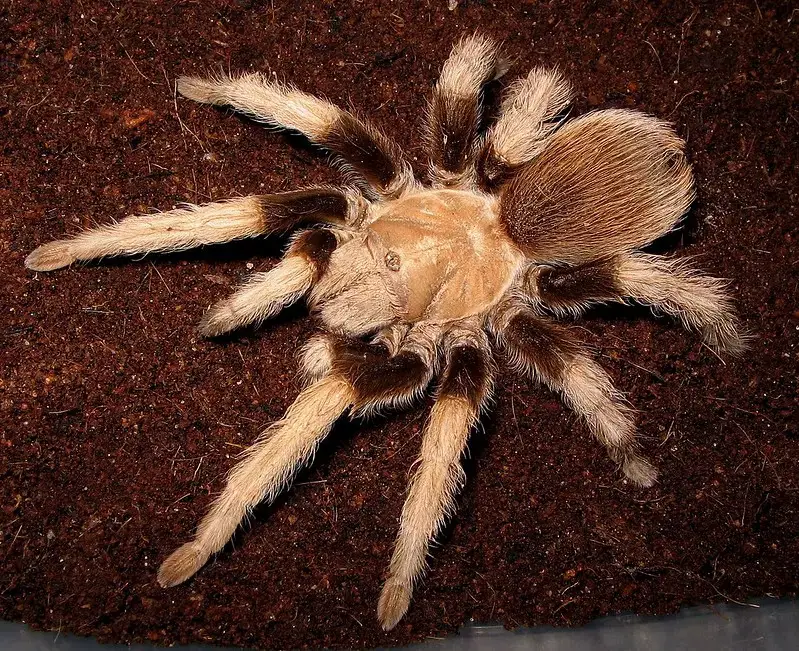
Aphonopelma chalcodes, commonly known as the Arizona Blonde Tarantula or Desert Blonde Tarantula, is a striking species found in southwestern New Mexico near desert mountain ranges and arid plains. Its name comes from its golden-blonde carapace and lighter hairs covering the legs and abdomen. Adult females are slightly larger than males, with a leg span of 5 to 6 inches, while males are slimmer and often display a darker coloration during the breeding season.
This species is adapted to life in the desert, where temperatures can be extreme. It spends much of its life inside silk-lined burrows, which can extend up to two feet deep to maintain a stable microclimate. During the cooler months, Aphonopelma chalcodes becomes less active, conserving energy until temperatures rise. In summer, it emerges to hunt insects, beetles, and small arthropods, ambushing prey with quick bursts of movement.
Despite its intimidating appearance, the Desert Blonde Tarantula is docile and rarely aggressive toward humans. When disturbed, it may flick urticating hairs from its abdomen as a defense mechanism, causing mild irritation to skin or eyes. Because of its gentle nature and attractive coloring, it is a popular species among arachnid enthusiasts and hobbyists.
In New Mexico, this tarantula inhabits regions along the southern border, particularly near the Chihuahuan Desert and mountain foothills. It prefers sandy or loose soil where it can easily construct burrows. The species plays an important ecological role by controlling insect populations and serving as prey for birds, reptiles, and small mammals. Females can live for up to 25 years, making them among the longest-lived tarantulas in North America.
Aphonopelma vorhiesi (Tucson Brown Tarantula)
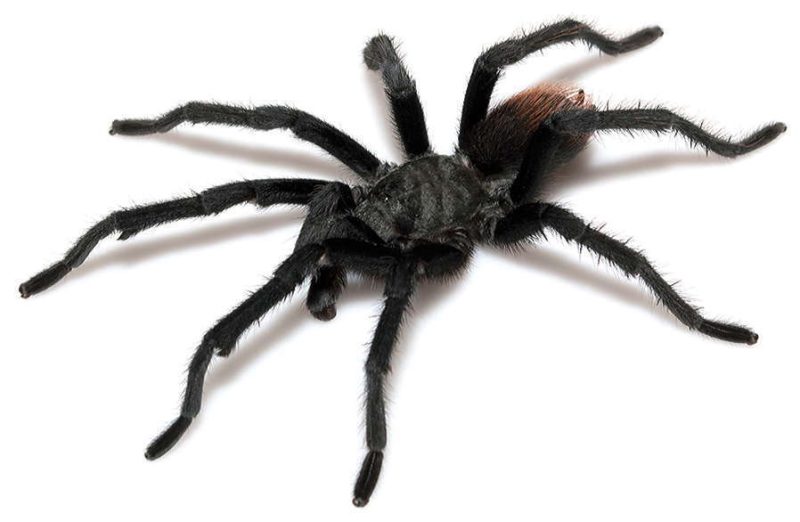
The Tucson Brown Tarantula, Aphonopelma vorhiesi, is a native desert dweller that ranges into southwestern New Mexico from southern Arizona. It has a uniform chocolate-brown coloration, giving it a more subtle appearance compared to the blonde or black species in the same region. Adults typically reach a leg span of 4 to 5 inches and have a compact, muscular body covered with fine hairs that help them detect ground vibrations from prey.
This species is most active during late summer and early fall, especially after rain, when males leave their burrows to search for females. They are mainly nocturnal hunters, preying on crickets, beetles, and small arthropods. The Tucson Brown relies on ambush tactics, using sensitive leg hairs to detect nearby movement before striking quickly to inject venom that paralyzes its prey.
Aphonopelma vorhiesi is well adapted to the desert and semi-arid grasslands of New Mexico’s southwestern corner. It builds burrows in sandy or rocky soil, often near plant roots or under rocks that offer protection from predators. The burrows are lined with silk, which strengthens the walls and helps retain humidity in dry environments.
Females can live for up to two decades, remaining mostly in their burrows throughout their lives, while males die soon after mating. Like other tarantulas in the region, this species is important for maintaining ecological balance by keeping insect populations in check. Its calm nature and hardy survival skills make it one of the characteristic arachnids of New Mexico’s desert landscape.
Aphonopelma gabeli (Gabel’s Tarantula)
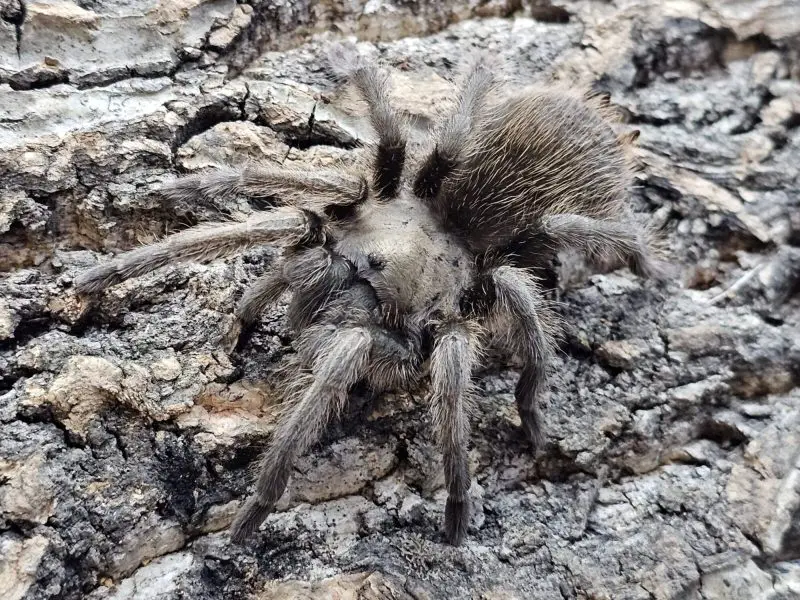
Aphonopelma gabeli, or Gabel’s Tarantula, is a lesser-known species inhabiting the desert grasslands and foothills of southern New Mexico. It is named after arachnologist Gabel, who helped document the regional diversity of Aphonopelma. This tarantula has a dark brown to black body, with subtle bronze or reddish highlights on the legs and carapace. Adult females typically reach a size of 4.5 to 5 inches across, while males are smaller and more slender.
Gabel’s Tarantula is a reclusive species that spends much of its life underground. It constructs silk-reinforced burrows that can reach depths of 12 to 18 inches, providing protection from predators and temperature extremes. The species becomes more visible during the monsoon season, when males wander in search of mates. Outside of the breeding season, they remain hidden, venturing out at night to capture small insects and other invertebrates.
In behavior, Aphonopelma gabeli is calm and deliberate. It relies on stealth and patience when hunting, ambushing prey that passes near the burrow entrance. The tarantula’s venom is mild and primarily used to immobilize prey rather than for defense. When threatened, it may use a defensive posture or release urticating hairs as a deterrent.
This species is native to arid and semi-arid regions of southern New Mexico, particularly around the Organ Mountains and other desert foothills. It prefers rocky, well-drained soils where it can create deep burrows. Like other Aphonopelma, females have remarkable longevity, often exceeding 20 years, making them a stable part of the desert ecosystem.
Aphonopelma sclerothrix
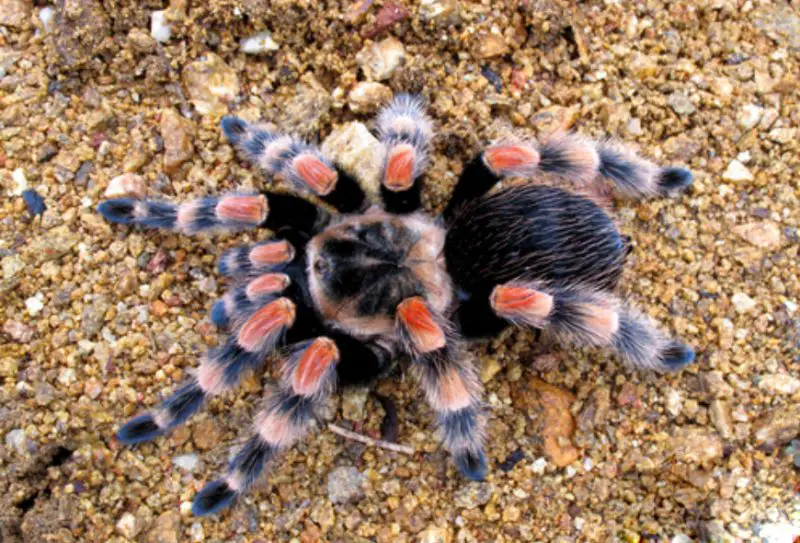
Aphonopelma sclerothrix is one of the rarer and less-studied tarantula species found in New Mexico. It is typically dark brown to nearly black, with a dense covering of fine hairs that give it a velvety texture. Adults can reach a leg span of 4 to 5 inches, though individuals vary in size depending on local environmental conditions. This tarantula’s robust build and earthy tones make it well suited for camouflage in rocky or sandy terrain.
The species is primarily nocturnal, emerging from its burrow at night to hunt beetles, grasshoppers, and other small invertebrates. During the day, it remains hidden in burrows that can extend deep underground, offering protection from the desert’s intense heat. Its burrows are often located near arroyos or under desert shrubs, where soil moisture remains slightly higher than in open areas.
Behaviorally, Aphonopelma sclerothrix is calm but cautious. It rarely displays aggression toward humans and will retreat into its burrow when disturbed. Like other tarantulas in the region, it may flick urticating hairs when threatened. Its slow metabolism and ability to withstand long periods without food make it well adapted to the harsh desert conditions of New Mexico.
This species is believed to inhabit parts of southern and central New Mexico, particularly in desert basins and foothill areas. Its elusive nature and low population density make sightings rare, contributing to the species’ limited documentation. Nevertheless, Aphonopelma sclerothrix remains an important component of the region’s arachnid biodiversity, playing a key role in the control of insect populations.
Aphonopelma armada (Nevada Tarantula)
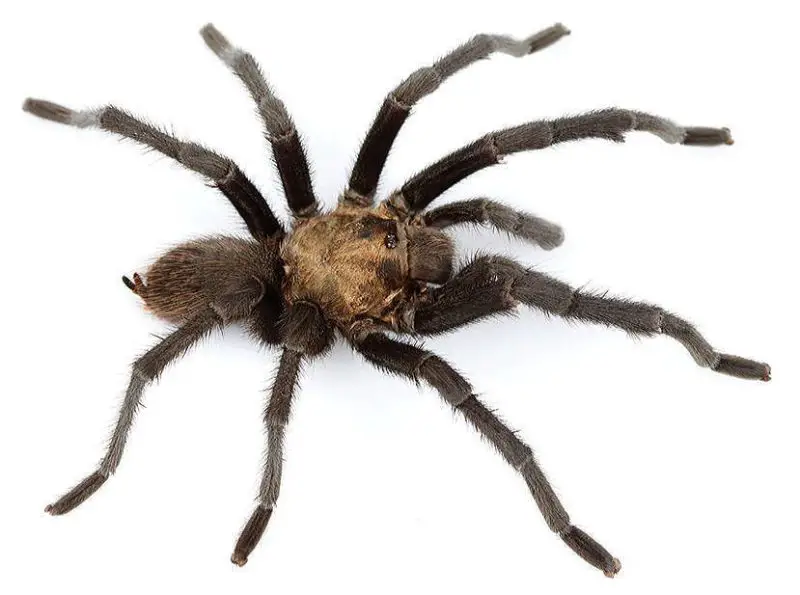
Aphonopelma armada, commonly known as the Nevada Tarantula, is a medium-to-large species found in parts of western and central New Mexico, extending from its core range in Nevada and Arizona. It has a dark, almost soot-brown body with faint reddish or bronze tones on the legs. Adults typically measure 4 to 5 inches in leg span, with females appearing bulkier and more robust than males. The dense covering of setae gives it a slightly glossy appearance that helps it blend seamlessly into the desert floor.
This tarantula is nocturnal and spends most of its life in silk-lined burrows dug into sandy or rocky soil. These burrows serve as protection against predators and help regulate temperature and humidity in arid environments. Aphonopelma armada hunts at night, feeding on crickets, beetles, and other ground-dwelling arthropods. Its ambush-hunting style relies on patience and precise vibration detection through sensitive leg hairs.
The species is well adapted to New Mexico’s desert climate, particularly in regions bordering Arizona and along dry basins with sparse vegetation. During the hottest months, it reduces activity to conserve energy and avoid dehydration. After summer rains, males emerge in search of females, often traveling long distances across open terrain.
Female Nevada Tarantulas can live for more than 20 years, while males typically die soon after mating. Their long lifespan and stable population across the desert make them an important ecological predator. Despite their fearsome appearance, they are non-aggressive and rarely bite unless threatened, making them a fascinating yet harmless resident of New Mexico’s wildlands.
Aphonopelma peloncillo (Peloncillo Mountains Tarantula)
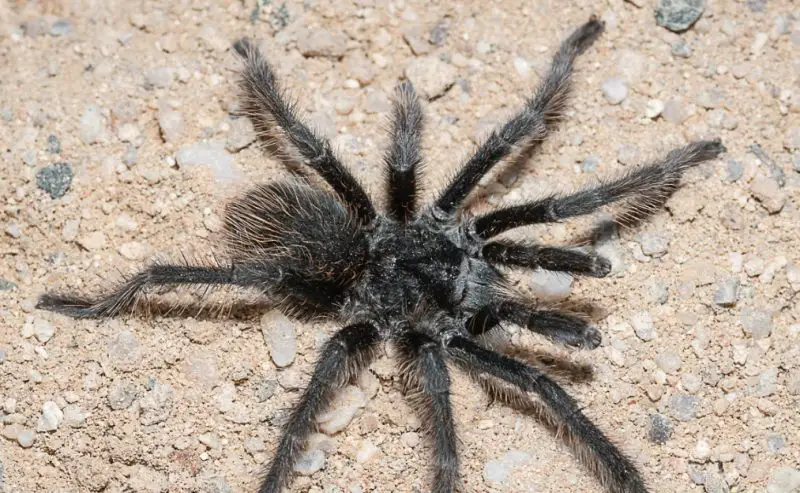
The Peloncillo Mountains Tarantula, Aphonopelma peloncillo, is a rare species found in the extreme southwestern corner of New Mexico, near the Peloncillo Mountains bordering Arizona. It is one of the lesser-known tarantulas in the region, with a medium-sized body measuring about 3.5 to 4.5 inches across. Its coloration is typically dark brown or black, with lighter leg joints and subtle reddish setae on the abdomen, giving it a rugged desert appearance.
This species inhabits semi-arid and mountainous environments, preferring rocky slopes, desert foothills, and canyon areas where it can create burrows under rocks or within soft soil. These burrows offer stable microclimates crucial for survival in regions where temperature swings between day and night can be extreme. Aphonopelma peloncillo emerges primarily at night to hunt insects and small arthropods that wander near its burrow entrance.
Behaviorally, it is shy and reclusive, often retreating at the slightest disturbance. It relies on its cryptic coloration and burrow concealment for defense rather than aggression. Like other Aphonopelma species, it can flick urticating hairs as a deterrent when threatened. During the breeding season, males can sometimes be observed wandering in the evening, particularly after monsoon rains.
The Peloncillo Mountains Tarantula is of special interest to researchers because it represents an isolated population adapted to a narrow range in southern New Mexico. Its limited distribution and elusive habits make it one of the state’s rarest arachnids. Conservation of its habitat is essential, as this mountainous desert region supports a unique mix of species found nowhere else.
Aphonopelma superstitionense
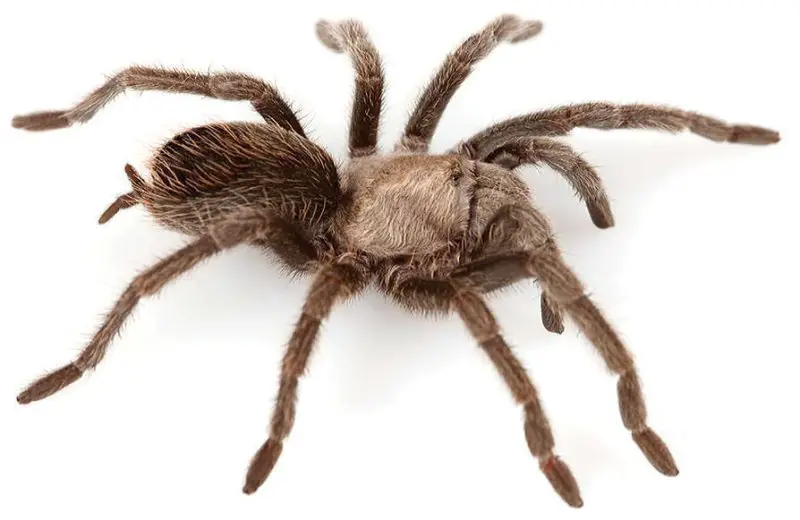
Aphonopelma superstitionense is a species first described in the deserts surrounding the Superstition Mountains of Arizona, but it also extends into southern New Mexico’s desert ecosystems. It is a medium-sized tarantula with a leg span of approximately 4 inches. Its coloring varies from light brown to dark gray, often with a subtle copper sheen on the cephalothorax and legs. This cryptic coloration helps it blend in with rocky and sandy desert terrain.
The species is primarily nocturnal and spends most of its life inside silk-lined burrows, which are often built under rocks or shrubs. These burrows protect it from predators such as lizards, birds, and small mammals while providing insulation against the harsh desert temperatures. At night, the tarantula emerges to hunt crickets, beetles, and other small prey, ambushing them with speed and precision.
In terms of behavior, Aphonopelma superstitionense is calm and non-aggressive, typical of North American tarantulas. When disturbed, it may raise its front legs or flick urticating hairs, but it prefers to retreat to safety rather than confront threats. Its venom is mild and poses little danger to humans.
In New Mexico, this species is found in arid regions of the southwestern deserts, often overlapping with other Aphonopelma populations. It thrives in rocky foothills, open plains, and sparsely vegetated scrublands. Although not commonly seen, Aphonopelma superstitionense plays an important ecological role as both predator and prey in the desert food web, helping to maintain a natural balance among invertebrate species.
Aphonopelma marxi (Colorado Plateau Blonde Tarantula)
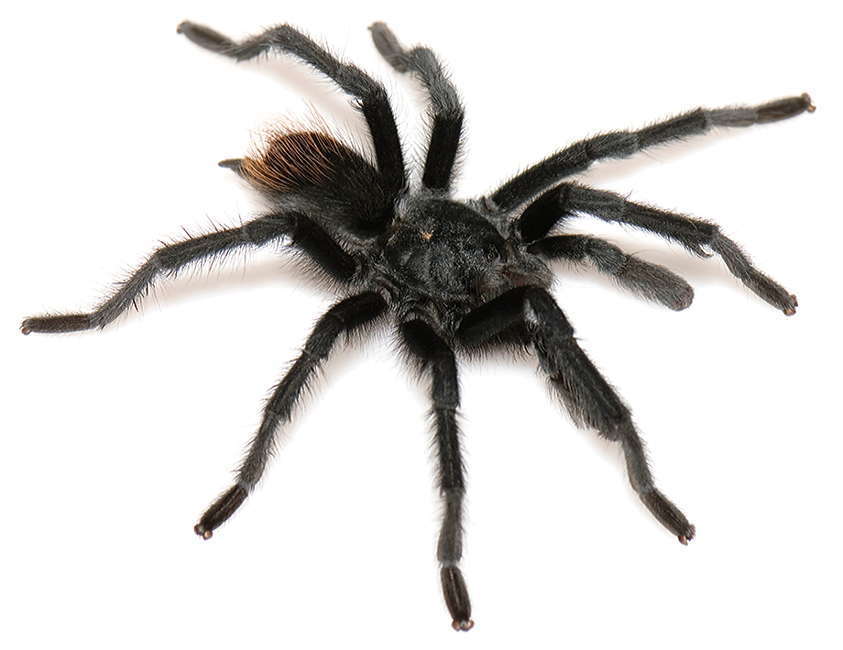
Aphonopelma marxi, commonly called the Colorado Plateau Blonde Tarantula, is one of the more northern-ranging species found in New Mexico, particularly in the northwest regions near the Four Corners area. It has a striking appearance, with a light tan or golden carapace and darker legs and abdomen. Adults can reach up to 5 inches in leg span, with females being more heavily built and longer-lived than males.
This species thrives in the semi-arid grasslands and canyonlands of the Colorado Plateau, where it digs burrows in well-drained soil or under rocks. The burrow serves as a year-round shelter that protects it from predators and extreme weather conditions. During the warmer months, it emerges at dusk to hunt grasshoppers, beetles, and other small invertebrates, using stealth and quick reflexes to overpower prey.
The Colorado Plateau Blonde Tarantula is gentle in temperament, making it one of the more approachable species in New Mexico. It relies on camouflage and retreat rather than aggression when threatened. During the mating season in late summer and early fall, males can be seen roaming the desert floor in search of females, often after rain events.
This tarantula’s habitat overlaps with other desert-dwelling species, but it prefers slightly higher elevations and cooler environments. Its pale coloration provides excellent camouflage against the sandstone and light soil of its habitat. Females may live up to 25 years, while males typically die within a year after reaching maturity. The species’ resilience and distinctive beauty make it an iconic representative of the tarantulas inhabiting northern New Mexico.
Aphonopelma parvum (Small Desert Tarantula)
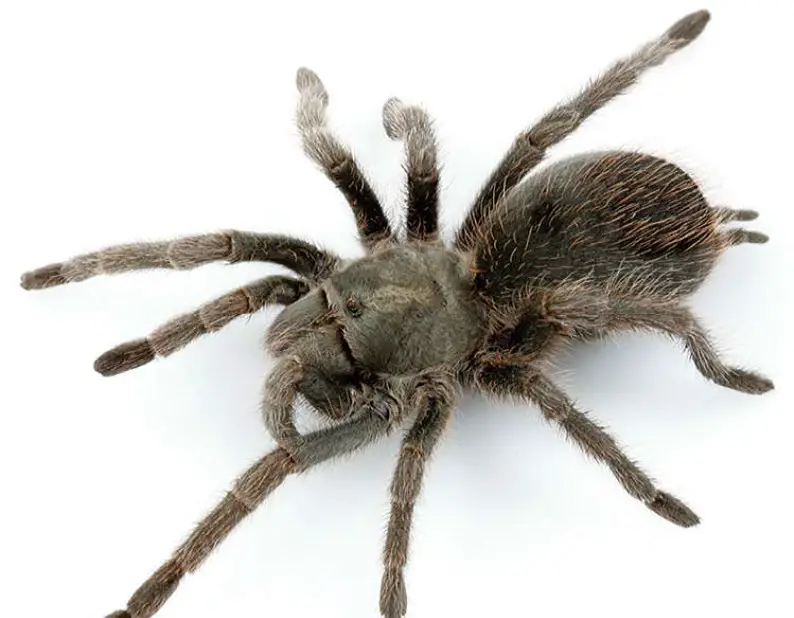
Aphonopelma parvum, known as the Small Desert Tarantula, is one of the smallest species of tarantulas native to New Mexico. Adults typically have a leg span of around 3 to 3.5 inches, making them noticeably smaller than most Aphonopelma species. Their coloration is dark brown to black, sometimes with faint bronze or reddish hues on the carapace and legs. Despite their size, these spiders exhibit the same formidable hunting instincts and resilience as their larger relatives.
This tarantula inhabits arid and semi-arid environments, particularly in southern and central New Mexico. It constructs shallow burrows in sandy or gravelly soil, often in open desert areas with sparse vegetation. Because of its smaller body size, Aphonopelma parvum is highly efficient at conserving moisture and can survive long periods without food or water. It hunts at night, preying on small insects and arachnids.
Behaviorally, Aphonopelma parvum is shy and secretive. It rarely strays far from its burrow and spends much of its life underground. Like other tarantulas, it can flick urticating hairs as a defense mechanism, but it is otherwise docile and non-aggressive. The small size and cryptic coloration make this species difficult to observe in the wild.
In New Mexico, it is most commonly found in the Chihuahuan Desert and foothill regions where loose soil allows easy burrowing. The Small Desert Tarantula’s ability to thrive in such harsh and dry conditions highlights its exceptional adaptability. Though not as commonly seen as larger species, it remains a fascinating example of evolutionary specialization among desert arachnids.
Aphonopelma vorhiesi complex (various local color morphs in southern NM)
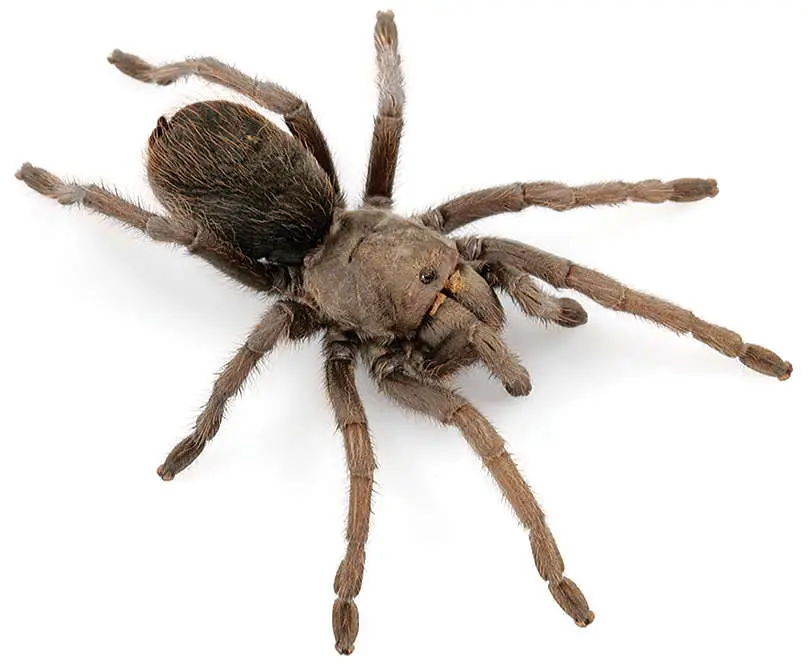
The Aphonopelma vorhiesi complex represents a group of closely related tarantulas with overlapping ranges and variable coloration, primarily found in southern New Mexico. These spiders display remarkable diversity in appearance, with some individuals showing deep brown or black bodies, while others exhibit lighter, sandy tones or reddish highlights. Adults typically range from 4 to 5 inches in leg span, with females being larger and more robust than males.
This complex inhabits arid deserts, scrublands, and foothill regions, where soil type and microclimate influence coloration and size. Burrows are typically dug beneath rocks, desert shrubs, or within loose, sandy soil, and are lined with silk to prevent collapse. The burrows serve as protection against predators and temperature extremes while maintaining humidity levels necessary for survival and molting.
Behavior among members of the vorhiesi complex is consistent with other Aphonopelma species: they are nocturnal hunters, ambushing insects and small invertebrates that come near their burrow entrance. During late summer, males emerge in search of females, often seen crossing roads or open terrain after rain. Females remain largely sedentary, defending their burrows and producing egg sacs during the breeding season.
The Aphonopelma vorhiesi complex illustrates how subtle environmental differences across southern New Mexico contribute to local adaptations and color variations within tarantula populations. This group continues to attract scientific interest, as researchers work to better understand the genetic and ecological factors behind their diversity. Their quiet presence and resilience make them emblematic of the hidden wildlife that thrives in New Mexico’s desert ecosystems.
Tips for Observing Tarantulas in New Mexico
Observing tarantulas in New Mexico is a rewarding experience for anyone fascinated by desert wildlife. These impressive spiders are most active during late summer and early fall, especially after monsoon rains when males begin their search for mates. The best time to observe them is at dusk or after dark, when they leave their burrows to hunt or wander across the desert floor. Use a flashlight or red-filtered headlamp to spot their reflective eyes without disturbing them.
When searching for tarantulas, focus on desert grasslands, rocky slopes, and foothills with loose, sandy soil. Look for silk-lined burrow entrances or small soil mounds beneath shrubs or rocks—these often mark a tarantula’s home. Approach quietly and avoid sudden movements, as vibrations can send them scurrying back underground. If you’re lucky, you may see males traveling across open terrain or females guarding their burrow entrances.
Always observe from a respectful distance and never attempt to handle wild tarantulas. They are docile but may flick urticating hairs if they feel threatened, which can cause skin irritation. Tarantulas play an important ecological role by controlling insect populations, so it’s best to admire them without interference. Bring a camera with a macro lens or zoom setting for close-up photos without getting too near.
For the best chances of seeing tarantulas in New Mexico, plan outings between July and October in southern regions such as the Chihuahuan Desert, Organ Mountains, and Peloncillo Mountains. These areas offer ideal conditions for multiple Aphonopelma species, providing a fascinating glimpse into the secret lives of these remarkable desert arachnids.
FAQs About Tarantulas in New Mexico
When are tarantulas most active in New Mexico?
Tarantulas are most active from late summer through early fall, particularly between July and October. This period coincides with their mating season when males leave their burrows to find females. After this time, activity decreases as temperatures drop.
Are tarantulas in New Mexico dangerous to humans?
No, tarantulas in New Mexico are not dangerous to humans. Their venom is mild, comparable to a bee sting, and they rarely bite unless provoked. However, their urticating hairs can cause irritation to skin or eyes if they feel threatened.
Where can I find tarantulas in New Mexico?
Tarantulas are found across southern and central New Mexico, thriving in deserts, grasslands, and rocky foothills. They are common in areas like the Chihuahuan Desert, Organ Mountains, and near the Arizona border. Look for silk-lined burrows or tarantulas wandering after rain.
How long do tarantulas live in the wild?
Female tarantulas in New Mexico can live up to 20–25 years, while males generally live only 5–10 years, dying shortly after mating. Their slow growth and long lifespan make them one of the most enduring invertebrates in the desert ecosystem.
What do tarantulas eat in New Mexico?
Tarantulas are carnivorous and feed on insects such as crickets, beetles, and grasshoppers. Larger individuals may also consume small lizards or other spiders. They hunt by ambushing prey that passes near their burrow entrance, using venom to subdue it.
Can tarantulas be kept as pets?
Yes, several New Mexico tarantulas—like the Arizona Blonde (Aphonopelma chalcodes) and Texas Brown (Aphonopelma hentzi)—are popular in the pet trade due to their calm nature. It’s crucial, however, to ensure they are captive-bred rather than collected from the wild.
Why are tarantulas seen crossing roads in late summer?
During mating season, male tarantulas leave their burrows and wander across open ground, often crossing roads in search of females. This behavior is most common after summer rains when humidity rises. Though it may look like an “invasion,” it’s a natural and temporary event.
Do tarantulas have natural predators in New Mexico?
Yes, tarantulas have several predators, including tarantula hawk wasps, snakes, birds, coyotes, and small mammals. The tarantula hawk wasp is particularly notorious—it paralyzes tarantulas and uses them as living food for its larvae.
Are tarantulas active during the day?
Tarantulas are mostly nocturnal and stay inside their burrows during the day to avoid heat and predators. Occasionally, they may appear outside after rain or when searching for mates, but daytime sightings are rare.
Do tarantulas dig their own burrows?
Yes, tarantulas are skilled diggers and excavate their own burrows using their legs and fangs. These burrows can reach several inches to a foot deep and are lined with silk to prevent collapse. The burrow provides safety, humidity, and a stable temperature for molting.






